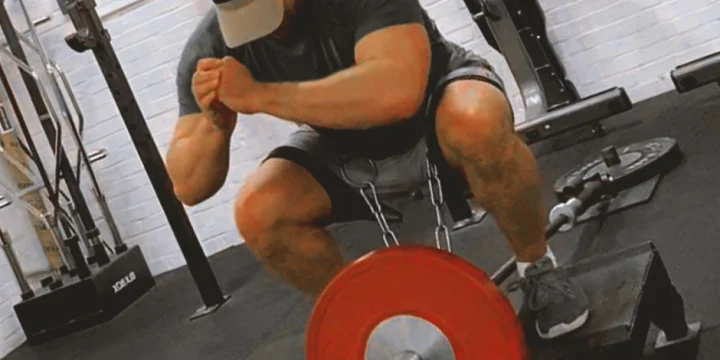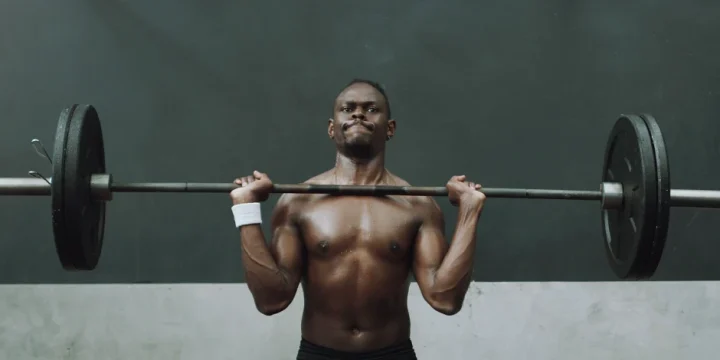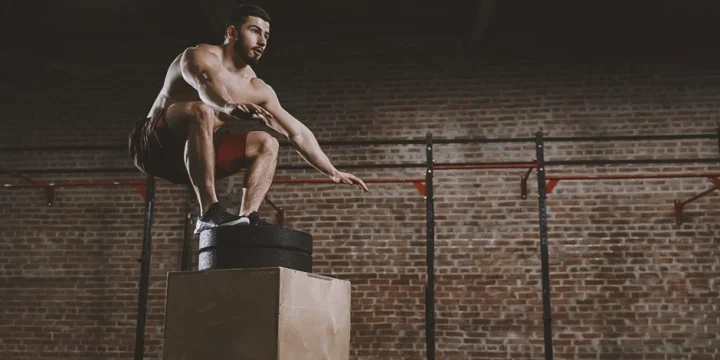Box jumps are a popular exercise among athletes for their comprehensive benefits.
Box jumps benefit our legs, lower back, and core.
They also improve other exercises, like jumping rope or running, and are incredibly functional.
As a fitness expert coach, I know it's important to understand the best way to perform jump boxes.
Here's what I found.
Quick Summary
- To do box jumps, your feet should face the front of the box, slightly bend your knees, push off the ground, and swing your arms forward before descending on the box.
- Incorporate the following if you don't have a box; a solid chair, a park bench, a workout bench, brick walls, or stairsteps.
- Regular practice of box jumps can significantly improve vertical leap and overall athletic performance.
- From a personal perspective, incorporating box jumps into workouts can be a fun and challenging way to boost fitness levels.
How To Do Box Jumps Correctly
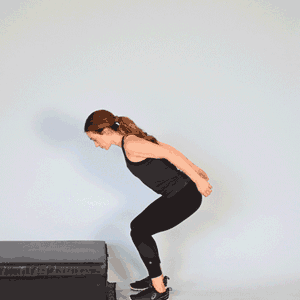
In 2016, Evan Ungar made a Guinness World Record by jumping onto a box 63.5 inches (1.61 meters) tall from the floor.
You might not be trying to break a world record anytime soon, but it's good to know what people are capable of.
Box jumps follow three basic steps:
- With your feet hip-width distance apart, facing in front of the box with your toes about six inches away.
- Bend your knees slightly and push off the ground with the balls of your feet, firing all your calf muscles and exploding into the air.
- In mid-air, just before you begin to descend from the height of your jump, bend your knees, swing your arms forward, and land softly and quietly with both feet on top of the box.
Extend your hips all the way up, then step down, repeat, and do it again and again.
Read More:

How To Incorporate Box Jumps With Or Without A Box

Just because you don't have a typical plyo box sitting around doesn't mean you can't exercise as if you're doing a traditional box jump.
The benefit of a box jump, from my personal experience, lies in the deep squat that powers the jump, the explosive force you exert during the leap, and the skill required to land softly and quietly. This combination challenges your muscles and hones your coordination and balance, making it a dynamic part of my workout routine.
Think Outside The Box!
You can get just as much benefit from these common plyo box exercise alternatives:
- A park bench
- Sturdy, wide stone or brick walls
- A workout bench
- A solid chair
- Stairsteps that are wide enough for you to land on safely
Any sturdy elevated surface about 12-21 inches (30-53cm) tall is a great starting point. Make sure the box, bench, chair, or whatever you're using doesn't wobble. Position them like a box with your feet just in front.
As you practice and develop jump training exercises into your workouts, you can use a higher box, around 21-31 inches (53-79cm).
Improve Your Box Jump With Explosive Power

Box jumps are a fast exercise movement and require a lot of explosive lift off the floor. They develop your body's type II muscle fibers needed for quick, explosive movements.
You can probably imagine yourself doing a box jump, even if you've never tried explaining or thinking about it. And many things can happen, including shin scrapes from slipping off the front of a box.
Hip, Feet, And Knee Placement Before, During, And After A Box Jump
Remember these pro tips for box jumps:
- Start with a deep or partial squat for more power.
- Land with both feet for stability, regardless of your skill level.
- Utilize arm swings to enhance stability and power.
- Aim for a quarter-squat stance upon landing, then stand fully to maximize the range of motion.
- Land softly from ball to heel to protect your knees from strain.
- Stand hip-width apart, with the box a foot away, to maintain balance.
- Opt for a lower box when recovering from injuries or adjusting difficulty.
Box Jump Scales And Maintaining Proper Form

As plyometric exercises go, nothing helps you build explosive power in your lower body than performing box jumps. But there are some ways to make jumping gentler on your body.
Adjusting Vertical Jump Height
Simply choosing a lower box height is the easiest option. You can get one as low as 12 inches (30cm) and still get a lot of exercise, especially if you're jumping on to it.
Consider this if you're just starting out, have an injury, are recovering from past exercises, or have a fear of the box. If you can't adjust the height of your box, consider adjusting from a quarter squat to a full squat when jumping.
Overcoming Box Jump Phobia With A Mirror, Phone, Or Partner
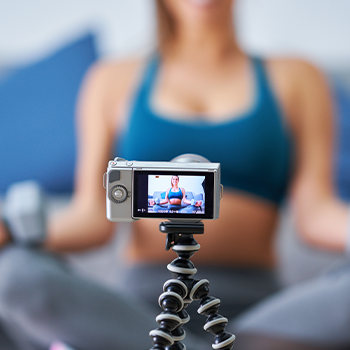
Many fear failing at box jumps, but it's often a mental barrier. In reality, you're likely jumping higher than you think.
Use a mirror or phone camera while jumping to prove it to yourself. This will show you the actual height you're achieving.
“Our results suggest that feedback involving a combination of self-feedback and expert video feedback with oral instruction effectively improved lower extremity kinematics during jump-landing tasks [1].”
- Jena Etnoyer Slaski, Researcher & Certified Trainer
No mirror or phone? Ask a friend to watch. If you're clearing the box by 6 inches (15 cm) or more, challenge yourself with a higher box to continue improving.
Protect Your Shins As You Fatigue
Know your limits. The fast-twitch muscle fibers in your legs will fatigue the more jumping you do. And your core will get wobbly as you land.
The most common issue is people misjudge the landing zone, land too far back, and a shin comes scraping down the front of the box.
In my experience, this typically happens because people are going too fast, and their form degrades or goes wrong.
Keep your knees bent on each jump, slow down, and be thoughtful. The benefits of this workout come from achieving height, not speed.
3 Additional Plyo Box Exercise To Consider

 1. Box Step-ups
1. Box Step-ups
Box jumps are great, but they're not for everyone or all the time.
Simply stepping up on the box, as you would on stairs, are also great ways to improve athletic performance. Twenty or more reps of a step-up, and you’ll be feeling it.
Step-ups also reduce the impact on your feet and knees. It’s a less explosive movement, but an excellent scale for anyone with prior injuries or mobility issues.
2. Pistols From A Box
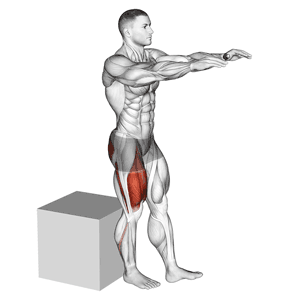
Pistols are a great warm-up and intense on your lower body. Unlike jumping with fast movements, pistols are slow and controlled.
Pistols are great for our body's "slow-twitch" muscle fibers, whereas type II muscle fibers use "fast-twitch" muscles during brief, powerful periods of activity.
- Stand with both feet on the edge of your box
- Bend one knee and push the other outside leg straight out. You'll be balancing on one foot.
- Bend all the way down and see if you can lower your single standing leg to the point your heel wants to raise up.
- Then stand back up and repeat, alternating sides.
Do three to five reps on each side, and you'll improve your ankle, calf, glute, hamstring, core, and quadriceps at the same time.
 3. Weighted Jumps And Step-ups
3. Weighted Jumps And Step-ups
Grab a weight vest, dumbbell, plate, kettlebell, or some other weight like water jugs for your step-ups.
I typically don't recommend jumping with a dumbbell or kettlebell because your center of gravity is all wrong. But a weighted vest is great. And It doesn't have to be much. A 20lb (9kg) weight vest is a lot for a box jump.
You can also mix-and-match step-ups with jumps. If you're doing a set of 20 box jumps, consider alternating between jumping and stepping, like this:
- 5 jumps
- 10 step-ups (unweighted or with a weight vest or small dumbbell)
- 5 jumps
Related articles:
FAQs
What Kind of Box Is Best?
There is no "best box." Whatever is sturdy, stable, and accessible for you to do jumping exercises around is great.
How Can I Build Confidence with Box Jumps?
Practice and record or watch yourself in a mirror. Those mirrors in the gym are there for a reason, and they're there to help you improve your form. They can also show you how much height you're really achieving.
How Can I Manage Box Jumps with an Injury?
Ask your doctor for guidance, but generally, you'll want to reduce reps and impact. Step-ups are the best alternative.
My Kneecaps Hurt during Landing. Is That Normal?
Yes and no. Yes, a lot of people get joint pain from any kind of jumping, but that's usually because they're not keeping good form or, as is the case with a lot of athletes: they need regular rest days.
What Should I Do With My Arms during a Box Jump?
I like to swing my arms up and down, almost like I'm throwing a slam ball on the ground. I've seen others who prefer to keep them close to their sides and land with their arms right out in front.
Whatever suits you will work.
What Is the Recommended Height for a Box Jump?
A foot (30cm) is great for first-timers and kids. Around 21 inches (53cm) is pretty standard for most gyms and CrossFit training. Tall people may want to edge up to 24 inches (60cm) as a starting point.
References:
- https://pubmed.ncbi.nlm.nih.gov/23672380/
About The Author
You May Also Like
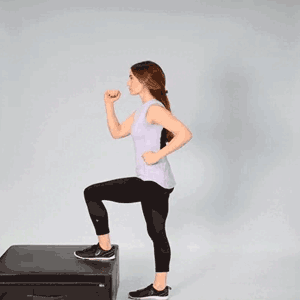 1. Box Step-ups
1. Box Step-ups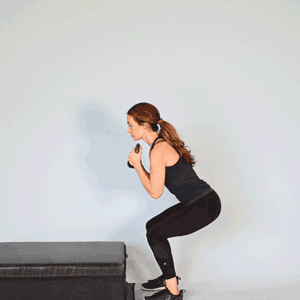 3. Weighted Jumps And Step-ups
3. Weighted Jumps And Step-ups